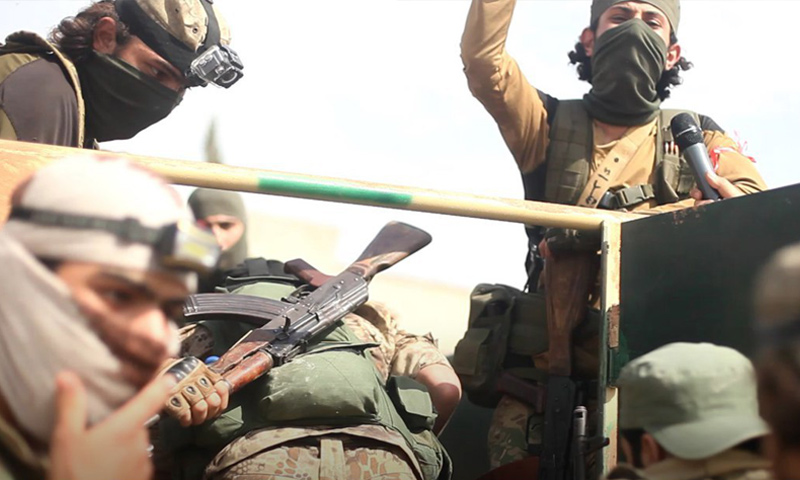The military operation that the opposition factions launched in northern rural Hama yesterday was different from other battles against Assad forces, for the confrontations did not take place within the areas held by them, but rather within the borders of the regime’s map of territorial control.
The battle had various names, changing from one faction to another, where the National Front for Liberation (NFL) gave it the name “Rebelling the Invaders,” HTS called it the “Battle of al-Muʿtaṣim biʾllāh al-Madani,” while Jaysh al-Izza (Army of Glory) dubbed it “Breaking the Bones.”
As the map of territorial control shows, the opposition factions have conquered an unexpected front under their current military operation, which perimeters start at the areas they control in the city of Ltamenah and its vicinity, in the direction of Tal Meleh village, al-Jbain and Kafrhood.
Comparing the progress of the last days’ battles with the current ones’, it becomes clear that the opposition factions have focused all their past battles on a single front, which is that of Kafr Nabudah town. The front has more than once bore witness to power shifts between the opposition factions and the Assad forces, which kept it in their grip lately, slowly advancing to the north-western part of it, where they took over the Qasabiyeh village, in southern rural Idlib.
During the current military operation, the factions have adopted a new strategy, as they created a detour with taking the battles to Syrian regime-held areas, away from those held by the opposition, which the town of Kafr Nabudah represents basically.
The battles targeted the following areas: Tal Meleh, al-Jbain, Kafrhood, al-Dahra School that are all within the range of Assad force’s control and which the opposition factions failed to achieve any progress towards in years.
Land Forces Tactic
Military operations have their own tactics, which are considered a science in themselves, says Lieutenant Colonel Fares Bayoush, a former leader of the Free Syrian Army (FSA).
Bayoush also told Enab Baladi that the Syrian opposition factions in the current battle have followed the “land force” tactic, one term of which says that key attacks must not concentrate on the front from which the “opposing forces” progress. Contrastingly, several fronts must be involved as to distract the opponents.
The military leader explained that the factions have broken all the strategies they followed earlier on at the rural Hama and Idlib fronts with this new tactic, being “efficient and of capable of achieving great results.”
The Syrian regime has lately been trying to exhaust the opposition factions by dragging them into the town of Kafr Nabudah, during which the factions sought to cause several human casualties in the ranks of the Assad forces, regardless of territorial control.
Bayoush believes that to the Syrian regime human casualties are not a source of trouble, as it is apparently seeking to rid of the reconciled forces, which it is thrusting into the first lines of the battles in the northern and western rural parts of Hama.
The leader has additionally stressed that shifting the battlefield from the town of Kafr Nabudah is “good and bears great results,” pointing out that “other fronts and axes must be involved, especially since the opposition factions are equipped with needed capabilities to do so.”
The opposition factions’ attack came a few days after the massive progress achieved by Assad forces in the north-western rural parts of Hama, as far as Idlib’s southern countryside, where they controlled the village of Qasabiyeh and the farms surrounding it.
Controlling the two villages of Tal Meleh and Kafrhood has helped the opposition factions block the roads between Muhradah and Suqaylabiyah, thus moving the confrontations to the gates of the Tremseh city.
Would Factions Preserve Their Posts?
To the time this report was written, the opposition factions still kept control of their posts in the areas they progressed to in northern rural Hama, which are al-Jbian, Tal Meleh and Kafrhood.
They have also opened a new front towards the Qasabiyeh village in southern rural Idlib, which includes the area of the Qiratah farms and the al-Karakat in western rural Hama.
Facing the current reality, many questions are being raised concerning the opposition factions’ ability at sticking to and preserving the posts they controlled with the ongoing aerial shelling by the Russian warplanes and helicopters.
Bayoush believes that sustainability during any battle is “the sustainability of the decision. […] As long as a decision exists as to initiate battles, the factions will continue. If they do not own the initiative, things will change.”
The leader expects intervention on the part of the guarantor states, Turkey and Russia, as to bring back the forces’, Assad forces and the opposition faction, presence on the ground to the way it used to be a month ago.
Neither Turkey nor Russia has commented on the developments of the territorial situation in the northern and western rural parts of Hama so far.
In the past two days, Turkey deployed reinforcements to its observation posts in Shair al-Maghar in the Shashabo Mountain and Murak in northern rural Hama.
At the onset of 2018, the Turkish army started establishing the now 12 observation posts in Idlib, under the “de-escalation” deal.
On May 22, Hulusi Akar, the Turkish Minister of Defense, stated that his country will not withdraw its forces from Idlib governorate in the shadow of the military escalation, with which Assad Forces are targeting the area.
“The Turkish Armed Forces will not retreat from where it is located,” Akar added.











